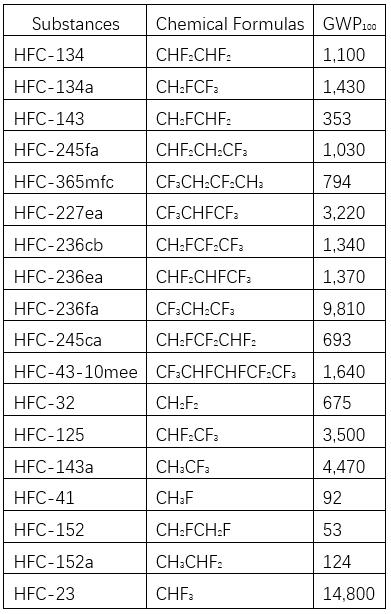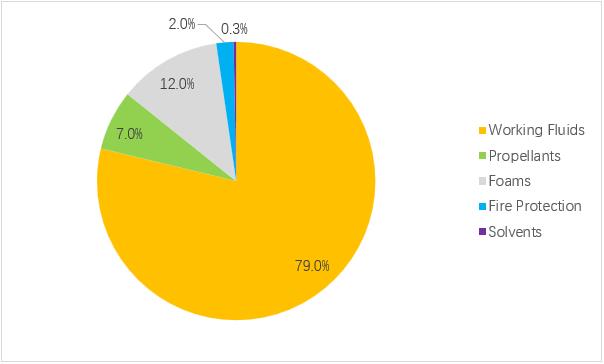<The Montreal Protocol on Substances that Deplete the Ozone Layer> is a global agreement to protect the Earth’s ozone layer by phasing out ozone depleting substances (ODS). It came out in 1987 and entered into force in 1989. After that, it has made several amendments to adjust the list of chemicals. Since then, chlorofluorocarbons (CFCs) and hydrochlorofluorocarbon (HCFCs) have been phased out due to their high ozone depletion potential (ODP) and replaced by hydrofluorocarbons (HFCs) by various countries.
Scientists discovered that although HFCs do not cause ozone depletion, they are powerful greenhouse gases that can cause climate change. Their long-term presence in the atmosphere over a period of 100 years has a potential to cause global warming (GWP100), and the GWP100 is tens to thousands of times greater than that of carbon dioxide. Therefore, in 2016, the United Nations Environment Programme issued <The Kigali Amendment> to <The Montreal Protocol> at the meeting in Kigali, Rwanda, adding 18 HFCs to the list of chemicals that countries have committed to gradually reduce the production and consumption (refer to Table 1).

<The Kigali Amendment> classifies the contracting parties into four groups according to <The Montreal Protocol> Article 5, and imposes restrictions on developed countries and developing countries respectively. Each group of countries has different HFCs baselines and progressive reduction schedules.
These four groups of countries are classified as:
Non-A5, earlier start: includes most developed countries (non Article 5 countries), such as the United States, Japan, EU countries, Australia, etc.; Their HFCs production and consumption baseline is 15% HCFCs baseline level + the average level of HFCs from 2011 to 2013; They are committed to cut their HFCs production and consumption to 90% baseline by 2019, then 60% by 2024, 30% by 2029, 20% by 2034, and 15% since 2036.
Non-A5, later start: Russia, Belarus, Kazakhstan, Tajikistan, Uzbekistan; Their HFCs production and consumption baseline is 25% HCFCs baseline level + the average level of HFCs from 2011 to 2013; They are committed to cut their HFCs production and consumption to 95% baseline by 2020, then 65% by 2024, 30% by 2029, 20% by 2034, and 15% since 2036.
A5, group 1: Most Article 5 countries, such as China, South Korea, Thailand, Brazil, etc.; Their HFCs production and consumption baseline is 65% HCFCs baseline level + the average level of HFCs from 2020 to 2022; They are committed to control their HFCs production and consumption within baseline by 2024, then cut to 90% by 2029, 70% by 2035, 50% by 2040, and 20% since 2045.
A5, group 2: Bahrain, India, Iran, Iraq, Kuwait, Oman, Pakistan, Qatar, Saudi Arabia, United Arab Emirates; Their HFCs production and consumption baseline is 65% HCFCs baseline level + the average level of HFCs from 2024 to 2026; They are committed to control their HFCs production and consumption within baseline by 2028, then cut to 90% by 2032, 80% by 2037, 70% by 2042, and 15% since 2047.
The above calculations refer to GWP100 CO2 equivalent of HCFCs and HFCs.

According to scientific estimates, if all countries strictly comply with the reduction requirements of <The Kigali Amendment>, the annual emissions of HFCs will be reduced by 5.6-8.7 billion tons of CO2 equivalent, and will decrease to below 1 billion tons of CO2 equivalent per year by the end of this century, which can slower the average global warming temperature by 0.4 ℃, prevent a large number of glaciers from melting, and protect large areas of farmland from sea level rising.
In order to protect the earth home, all countries are actively responding to the call of the United Nations Environment Programme and fulfilling their obligations according to the requirements of <The Montreal Protocol> and <The Kigali Amendment>.
CFCs, HCFCs and HFCs are currently mainly used as working fluids in the organic Rankine cycle (ORC) of various heat pumps, due to their low boiling point, evaporative endothermic expansion and other characteristics. Their application fields include household and industrial heat pumps, as well as refrigerants in refrigerators, air conditioners, and industrial refrigeration. They are also used as propellants in aerosols, and foaming agents used in the preparation of foam materials for thermal insulation and buffers. The application proportions of CFCs, HCFCs, and HFCs in the market are shown in Figure 2.

These applications are indispensable in modern production and daily life, therefore, finding substitutes for CFCs, HCFCs, and HFCs has become a top priority.
As a responsible and capable fluorine chemical manufacture enterprise, Yuji has conducted a lot of scientific research in this field. Currently, Yuji has successfully developed several hydrofluro-olefins (HFOs) products, which can perfectly replace CFCs, HCFCs, and HFCs in heat pumps, foaming and other fields. The ODP and GWP100 values and main applications of some HFOs products in Yuji are detailed in Table 2.

HFOs have the similar performances as CFCs, HCFCs, and HFCs, including low boiling point, evaporative endothermic expansion. At the same time, because their molecular structures contain carbon double bonds, their lives in the atmosphere are much shorter, they can decompose in only a few days, and the decomposition products will not harm the environment, so their ODP and GWP100 are extremely low, that is why they are almost the best choices in this field at present.
For the welfare of all humanity, let us forge ahead together with Yuji.
[1] UNEP, ozone.unep.org
[2] Current Use of HCFCs and HFCs, OzonAction, UNEP
[3] Yuji Sifluo, www.yuji-sifluo.com/en